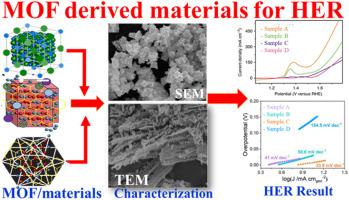迈向绿色能源:金属-有机骨架及其衍生的析氢水裂解制氢催化剂的研究进展
IF 7.9
2区 工程技术
Q1 CHEMISTRY, PHYSICAL
引用次数: 0
摘要
析氢反应(HER)是一种很有前途的通过电催化水裂解制氢技术,解决了全球能源需求。金属有机骨架(mof)及其衍生物由于其独特的性能,包括高表面积、可调孔隙率和可修饰的金属中心,在HER催化剂中得到了相当大的关注。本文综述了近年来基于mof的制氢电催化剂的研究进展,重点介绍了各种mof改性技术对其性能的提高。此外,还讨论了HER的机理,重点讨论了ΔGHads和电子结构调制在优化催化活性中的关键作用,无论是否掺杂元素。然而,在可扩展性、在酸性和碱性条件下的稳定性以及成本效益方面仍然存在挑战。最后,讨论了基于mof的催化剂在HER中的应用前景以及克服这些缺点的潜在解决方案,以促进可持续和替代清洁能源的发展。本文章由计算机程序翻译,如有差异,请以英文原文为准。

Towards green energy: Progress in metal-organic framework and their derived catalysts for hydrogen production through water-splitting via the hydrogen evolution reaction
Hydrogen evolution reaction (HER) is a promising technology for generating hydrogen through electrocatalytic water splitting, addressing global energy demands. Metal-organic frameworks (MOFs) and their derivatives have gained considerable attention as catalysts in HER due to their unique properties, including high surface area, tunable porosity, and modifiable metal centers. This review presents recent progress in MOF-based electrocatalysts for hydrogen production and highlights their performances as well as property inhancement by various MOF-modifications techniques. Additionally, The HER mechanisms are discussed, with emphasis on the critical role of ΔGHads and electronic structure modulation, with or without doping of elements in optimizing catalytic activity. However, challenges remain regarding scalability, stability in both acidic and alkaline conditions, and cost-effectiveness. Finally, the prospects of MOF-based catalysts in HER and potential solutions to overcome these drawbacks are discussed to promote sustainable and alternative clean energy.
求助全文
通过发布文献求助,成功后即可免费获取论文全文。
去求助
来源期刊

Journal of Power Sources
工程技术-电化学
CiteScore
16.40
自引率
6.50%
发文量
1249
审稿时长
36 days
期刊介绍:
The Journal of Power Sources is a publication catering to researchers and technologists interested in various aspects of the science, technology, and applications of electrochemical power sources. It covers original research and reviews on primary and secondary batteries, fuel cells, supercapacitors, and photo-electrochemical cells.
Topics considered include the research, development and applications of nanomaterials and novel componentry for these devices. Examples of applications of these electrochemical power sources include:
• Portable electronics
• Electric and Hybrid Electric Vehicles
• Uninterruptible Power Supply (UPS) systems
• Storage of renewable energy
• Satellites and deep space probes
• Boats and ships, drones and aircrafts
• Wearable energy storage systems
 求助内容:
求助内容: 应助结果提醒方式:
应助结果提醒方式:


